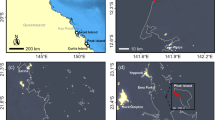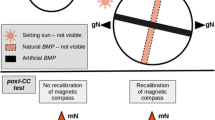Summary
The sensory basis and spatial range of orientation to the breeding site were studied in the toadBufo bufo, during two breeding seasons. Toads were displaced passively from their breeding pond and fitted with a tracking device to record the path of migration in individuals. The directional choice and the straightness of trails after release were used to quantify the effect of experimental treatments. In both years, control (untreated): toads headed to the breeding site with the same precision at all release sites. The initial orientation of toads blinded by opaque tape over their eyes. did not differ from controls, but the return paths were not as direct. The directional choice of anosmic toads was apparently random, however, individuals followed a straight path in a chosen direction. Anosmic toads also blinded were completely disoriented, moving in cycloid trails. Bar magnets glued to the head caused an increase in dispersion of toads. However, in some individual releases a directional bias without increased dispersion was observed. Sky conditions (clear or overcast) did not influence the initial orientation or the dispersion of toads. Nevertheless, the breeding site component was significantly correlated with wind direction in relation to the breeding site. Wind blowing from the breeding site improved the initial orientation, whereas wind from the opposite direction reduced the breeding site component. The spatial range for the ability to relocate the breeding pond after displacement exceeded 3 km, but the time taken to select the correct direction increased with the displacement distance. The results indicate that after displacement the initial orientation ofB. bufo is based mainly on olfactory and magnetic cues, with visual control of straightness.
Similar content being viewed by others
References
Able KP (1981) Mechanisms of orientation, navigation and homing. In: Gauthreaux SA (ed) Animal migration, orientation and navigation. Academic Press, New York, pp 283–383
Adler K (1976) Extraocular photoperception in amphibians. Photochem Photobiol 23:275–298
Adler K (1982) Sensory aspects of amphibian navigation and compass orientation. Vertebrata Hungarica XXI: 7–18
Batschelet E (1981) Circular statistics in biology. Academic Press, London New York
Carey C (1979) Aerobic and anaerobic energy expenditure during rest and activity in montaneBufo b. boreas andRana pipiens. Oecologia 39:213–228
Dole JW (1965) Summer movements of adult leopard frogs,Rana pipiens, in northern Michigan. Ecology 46:236–255
Dole JW (1972) Homing and orientation of displaced toads,Bufo americanus, to their home sites. Copeia 1972:151–158
Eibl-Eibesfeldt I (1950) Ein Beitrag zur Paarungsbiologie der Erdkröte (Bufo bufo L.). Behaviour 2:217–233
Ferguson DE (1971) The sensory basis of orientation in amphibians. Ann NY Acad Sci 188:30–36
Ferguson DE, Landreth HF (1966) Celestial orientation of Fowler's toad,Bufo fowleri. Behaviour 26:105–123
Gelder JJ van, Aarts HMJ, Staal HJWM (1986): Routes and speed of migrating toads (Bufo bufo L.): a telemetric study. Herpetol J 1:111–114
Gittins SP, Parker AG, Slater FM (1980) Population characteristics of the common toad (Bufo bufo) visiting a breeding site in Mid-Wales. J Anim Ecol 49:161–173
Grubb JC (1970) Orientation in post-reproductive Mexican toads,Bufo valliceps. Copeia 1970:674–680
Heusser H (1967) Wanderungen und Sommerquartiere der Erdkröte (Bufo bufo L.). Dissertation, Universität Zürich
Heusser H (1968) Die Lebensweise der Erdkröte,Bufo bufo L.: Wanderungen und Sommerquartiere. Rev Suisse Zool 75:928–982
Heusser H (1969) Die Lebensweise der Erdkröte,Bufo bufo L.: Das Orientierungsproblem. Rev Suisse Zool 76:444–517
BaIoalé P(1984) Magnets and pigeon orientation. Mon Zool Ital (NS) 18:347–358
Jungfer W (1943) Beiträge zur Biologie der Erdkröte (Bufo bufo L.) mit besonderer Berücksichtigung der Wanderung zu den Laichgewässern. Z Morphol Ökol Tiere 40:117–157
Kramer G (1953) Die Sonnenorientierung der Vögel. Verh Dtsch Zool Ges Freiburg 1952:72–84
Phillips JB (1977) Use of earth's magnetic field by orienting cave salamanders (Eurycea lucifuga). J Comp Physiol 121:273–288
Phillips JB (1986) Magnetic compass orientation in the Eastern red-spotted newt (Notophthalmus viridescens). J Comp Physiol A 158:103–109
Tracy RC (1971) Evidence for the use of celestial cues by dispersing immature California toads (Bufo boreas). Copeia 1971:145–147
Tracy RC, Dole JW (1969) Orientation of displaced California toads,Bufo boreas, to their breeding sites. Copeia 1969:693–700
Author information
Authors and Affiliations
Rights and permissions
About this article
Cite this article
Sinsch, U. Orientation behaviour of toads (Bufo bufo) displaced from the breeding site. J. Comp. Physiol. 161, 715–727 (1987). https://doi.org/10.1007/BF00605013
Accepted:
Issue Date:
DOI: https://doi.org/10.1007/BF00605013




